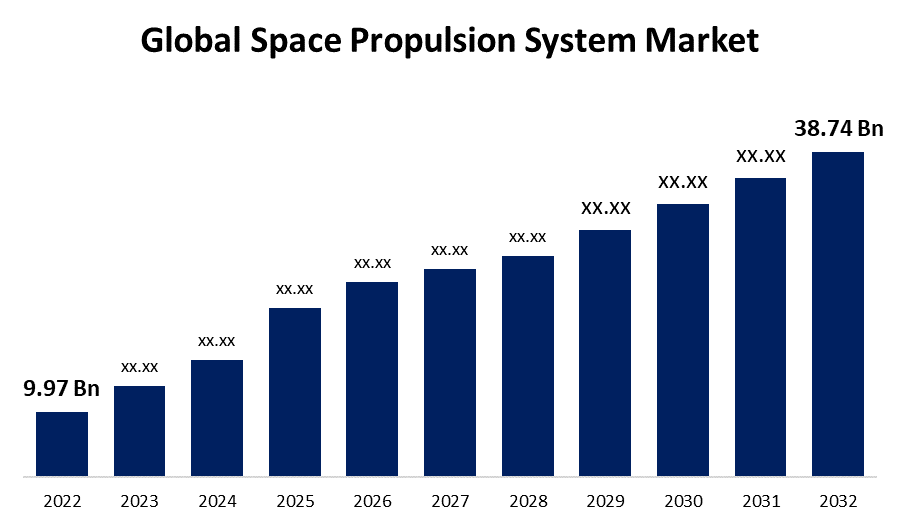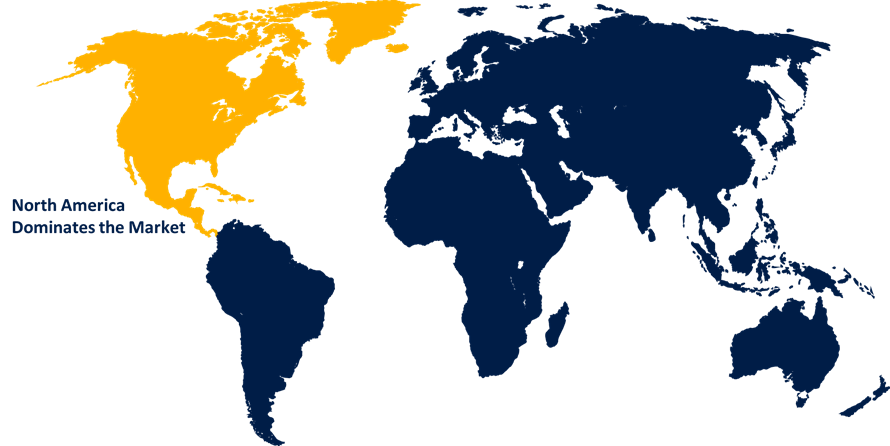Global Space Propulsion System Market Size, Share, and COVID-19 Impact Analysis By Type (Chemical Propulsion, Non-Chemical Propulsion), By System Component (Thrusters, Propellant Feed System, Nozzle, and Others), By Platform (Satellite, Launch Vehicle), By End-user (Commercial and Government & Defense), and By Region (North America, Europe, Asia-Pacific, Latin America, Middle East, and Africa), Analysis and Forecast 2022 – 2032.
Industry: Aerospace & DefenseGlobal Space Propulsion System Market Insights Forecasts to 2032
- The Global Space Propulsion System Market Size was valued at USD 9.97 Billion in 2022.
- The Market is growing at a CAGR of 14.5% from 2022 to 2032
- The Worldwide Space Propulsion System Market Size is expected to reach USD 38.74 Billion by 2032
- Asia Pacific is expected to grow the fastest during the forecast period

Get more details on this report -
The Global Space Propulsion System Market size is anticipated to exceed USD 38.74 Billion by 2032, growing at a CAGR of 14.5% from 2022 to 2032. The growing preference for electric propulsion for space exploration operations is a major driver of market revenue growth.
Market Overview
Space propulsion systems generate thrust in spacecraft, launch vehicles, capsules/cargoes, and rovers/spacecraft landers, among other things, for orbit insertion, station keeping, lifting launch vehicles into space, and attitude control. Any technique used to accelerate artificial satellites and spacecraft is referred to as spacecraft propulsion. In-space propulsion is the use of propulsion systems in vacuum space and should not be confused with atmospheric entry or space launch. The space propulsion market consists of entities providing related services or selling space propulsion products used to accelerate artificial satellites and spacecraft. A rocket engine is typically used to propel spacecraft. The space propulsion market is expected to expand rapidly due to an increase in space exploration missions, an increase in demand for low-Earth orbit-based services, and an increase in demand for satellite data. The "satellite" platform segment is projected to be the most rapidly expanding during the forecast period, owing to an increase in small satellite launches for government and commercial applications, as well as the rapid adoption of cutting-edge technology in CubeSats and small satellites.
Report Coverage
This research report categorizes the market for the global space propulsion system market based on various segments and regions and forecasts revenue growth and analyzes trends in each submarket. The report analyses the key growth drivers, opportunities, and challenges influencing the space propulsion system market. Recent market developments and competitive strategies such as expansion, product launch, and development, partnership, merger, and acquisition have been included to draw the competitive landscape in the market. The report strategically identifies and profiles the key market players and analyses their core competencies in each sub-segment of the space propulsion system market.
Global Space Propulsion System Market Report Coverage
| Report Coverage | Details |
|---|---|
| Base Year: | 2022 |
| Market Size in 2022: | USD 9.97 Bn |
| Forecast Period: | 2022 – 2032 |
| Forecast Period CAGR 2022 – 2032 : | 14.5% |
| 022 – 2032 Value Projection: | USD 38.74 Bn |
| Historical Data for: | 2018-2021 |
| No. of Pages: | 200 |
| Tables, Charts & Figures: | 140 |
| Segments covered: | By Type, By System Component, By Platform, By End-user and By Region. |
| Companies covered:: | Teledyne FLIR, Leonardo DRS, Collins Aerospace, Hensoldt, JAI, TetraCam Inc., Telops Inc., DJI, Paras Aerospace, Cubert GMBH, HGH Group, Opgal Optronics Industries Ltd., Unispectral, Silios technology and Others. |
| Pitfalls & Challenges: | COVID-19 Empact, Challenge, Future, Growth, & Analysis |
Get more details on this report -
Driving Factors
Because LEO satellites have numerous advantages such as lower launch costs, cost effectiveness, and availability of satellite parts, major players have prioritised their development. LEO satellites emit high-power signals that are 1,000 times (30 dB) more powerful than any GNSS signal. Signals can be received by LEO satellites from anywhere in the sky. Because LEO constellations have multiple satellites, they can provide 3-D location information as well as precise timing. Communication, scientific operations, logistics and geolocation, observation of the earth, signal tracking, and so on are some examples. Because of the numerous benefits and properties of LEO spacecraft, there is a high demand for space propulsion systems.
Military and defense forces rely on satellites for remote sensing technological devices, communications equipment, and GPS. Satellites provide more precise and accurate information about enemies and targets, reducing collateral damage and civilian & military casualties. Military satellites can overcome such limitations during wartime, when the ground communication system is frequently unavailable or unsecured. As the demand for such satellites or spacecraft for military purposes grows, so does space propulsion.
Restraining Factors
Increased emissions from space missions, as well as increased concerns about space debris, are some of the key variables prohibiting the expansion of the space propulsion system market, and are projected to remain so throughout the duration of the projections.
Market Segmentation
The Global Space Propulsion System Market share is classified into type, system component, and platform.
- The non-chemical propulsion segment is expected to grow at the highest pace in the global space propulsion system market during the forecast period.
The global space propulsion system market is categorized by type into chemical propulsion and non-chemical propulsion. Among these, the non-chemical propulsion segment is expected to grow at the highest pace in the global space propulsion system market during the forecast period. Solar propulsion is a cutting-edge propulsion technology that provides safety and superior propulsive power to support a wide range of space exploration missions. Solar cells are used to generate power in this system. A spaceship can gain velocity in two ways when using a laser propulsion system. The first method, which is used in solar sails and laser sails, uses photon radiation pressure to transfer momentum. The second technique, similar to a traditional rocket, uses the laser to assist in mass removal from the spaceship. The nuclear propulsion system is a propulsion system in which the primary power source is a nuclear reaction.
- The thrusters segment is expected to grow at the fastest pace in the global space propulsion system market over the projected period.
Based on the system component, the global space propulsion system market is divided into thrusters, propellant feed system, nozzle, and others. Among these, the thrusters segment is expected to grow at the fastest pace in the global space propulsion system market over the projected period. Thrusters are primarily used by satellites for maneuvering, orbital station-keeping, attitude supervision, and long-duration, low-thrust acceleration orbit under control. As a result, it is projected to dominate the space propulsion system market throughout the study period. In general, they can be pressure-fed or pump-fed. This pressure-supplied system is commonly used in auxiliary propulsion and space propulsion applications where low system pressures and sparse propellant supplies are required. The pump-fed system, on the other hand, is used in the high-pressure, high-performance application.
- The satellite segment is expected to hold the largest share of the global space propulsion system market during the forecast period.
Based on the platform, the global space propulsion system market is divided into satellite and launch vehicle. Among these, the satellite segment is expected to hold the largest share of the global space propulsion system market during the forecast period. The satellite market is rapidly expanding as a result of numerous applications such as satellite and spacecraft launch.
Regional Segment Analysis of the Global Space Propulsion System Market
- North America (U.S., Canada, Mexico)
- Europe (Germany, France, U.K., Italy, Spain, Rest of Europe)
- Asia-Pacific (China, Japan, India, Rest of APAC)
- South America (Brazil and the Rest of South America)
- The Middle East and Africa (UAE, South Africa, Rest of MEA)
North America is projected to hold the largest share of the global space propulsion system market during the study period.

Get more details on this report -
North America is expected to hold the largest share of the global space propulsion system market during the forecast period. This is due to the increasing number of small satellites launches and the entry of private players such as SpaceX, which have recently boosted the space industry. The expansion is attributed to a large space budget, a large number of commercial space organizations and market participants in this region, and a significant space industry.
Asia Pacific is expected to grow at the fastest pace in the global space propulsion system market during the forecast period. Asia-Pacific will witness rapid growth in the market. Increased government and commercial operations satellite launches as China, India, and Japan increase their space budgets. Defense utilities, increasing requirements for satellites across Asia Pacific, and other factors are driving the market. Increasing space expenditures and increasing military satellite projects from various APAC nations are driving market growth.
Competitive Analysis:
The report offers the appropriate analysis of the key organizations/companies involved within the global space propulsion system market along with a comparative evaluation primarily based on their product offering, business overviews, geographic presence, enterprise strategies, segment market share, and SWOT analysis. The report also provides an elaborative analysis focusing on the current news and developments of the companies, which includes product development, innovations, joint ventures, partnerships, mergers & acquisitions, strategic alliances, and others. This allows for the evaluation of the overall competition within the market.
List of Key Companies
- Accion Systems
- Mitsubishi Heavy Industries Ltd
- Aerojet Rocketdyne Holdings
- IHI Corporation
- Blue Origin
- Northrop Grumman Corporation
- Space Exploration Technologies
- Safran
- Airbus Se
- Thales Alenia Space
- Others
Key Target Audience
- Market Players
- Investors
- End-users
- Government Authorities
- Consulting And Research Firm
- Venture capitalists
- Value-Added Resellers (VARs)
Recent Developments
- In September 2022, Airbus has signed satellite communications contracts with the Dutch and Czech defence ministries. The armed services will use the Airbus UHF (Ultra High Frequency) military communications hosted payload on two or three channels, and it will be launched as part of the EUTELSAT 36D communications satellite in 2024.
Market Segment
This study forecasts revenue at global, regional, and country levels from 2020 to 2032. Spherical Insights has segmented the Global Space Propulsion System Market based on the below-mentioned segments:
Global Space Propulsion System Market, By Type
- Chemical Propulsion
- Non-Chemical Propulsion
Global Space Propulsion System Market, By System Component
- Thrusters
- Propellant Feed System
- Nozzle
- Others
Global Space Propulsion System Market, By Platform
- Satellite
- Launch Vehicle
Global Space Propulsion System Market, By End-user
- Commercial
- Government & Defense
Global Space Propulsion System Market, By Region
- North America
- US
- Canada
- Mexico
- Europe
- Germany
- Uk
- France
- Italy
- Spain
- Russia
- Rest of Europe
- Asia Pacific
- China
- Japan
- India
- South Korea
- Australia
- Rest of Asia Pacific
- South America
- Brazil
- Argentina
- Rest of South America
- Middle East & Africa
- UAE
- Saudi Arabia
- Qatar
- South Africa
- Rest of Middle East & Africa
Need help to buy this report?